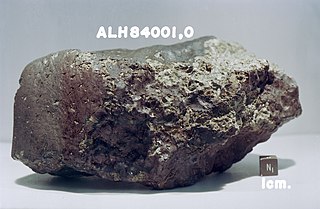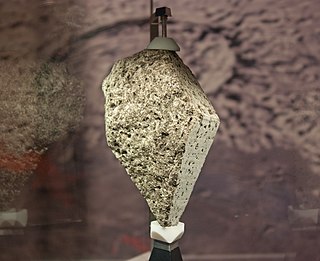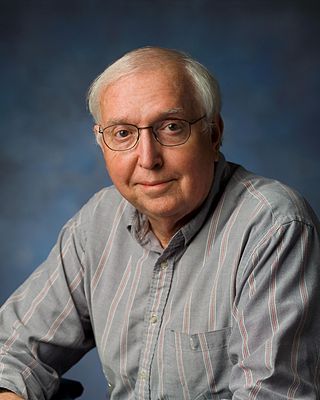Related Research Articles

A Martian meteorite is a rock that formed on Mars, was ejected from the planet by an impact event, and traversed interplanetary space before landing on Earth as a meteorite. As of September 2020, 277 meteorites had been classified as Martian, less than half a percent of the 72,000 meteorites that have been classified. The largest complete, uncut Martian meteorite, Taoudenni 002, was recovered in Mali in early 2021. It weighs 14.5 kilograms and is on display at the Maine Mineral & Gem Museum.

Allan Hills 84001 (ALH84001) is a fragment of a Martian meteorite that was found in the Allan Hills in Antarctica on December 27, 1984, by a team of American meteorite hunters from the ANSMET project. Like other members of the shergottite–nakhlite–chassignite (SNC) group of meteorites, ALH84001 is thought to have originated on Mars. However, it does not fit into any of the previously discovered SNC groups. Its mass upon discovery was 1.93 kilograms (4.3 lb).

A lunar meteorite is a meteorite that is known to have originated on the Moon. A meteorite hitting the Moon is normally classified as a transient lunar phenomenon.
Ben J. Bussey is an American planetary scientist.

The Genesis Rock is a sample of Moon rock retrieved by Apollo 15 astronauts James Irwin and David Scott in 1971 during the second lunar EVA, at Spur crater. With a mass of c. 270 grams, it is currently stored at the Lunar Sample Laboratory Facility in Houston, Texas.
Graham Ryder was an English geologist and lunar scientist.
George Wetherill was a physicist and geologist and the director emeritus of the department of terrestrial magnetism at the Carnegie Institution of Washington, DC, US.

Moon rock or lunar rock is rock originating from Earth's Moon. This includes lunar material collected during the course of human exploration of the Moon, and rock that has been ejected naturally from the Moon's surface and landed on Earth as meteorites.

Dante S. Lauretta is a professor of planetary science and cosmochemistry at the University of Arizona's Lunar and Planetary Laboratory. He is currently serving as the principal investigator on NASA's OSIRIS-REx mission.

The oldest dated rocks formed on Earth, as an aggregate of minerals that have not been subsequently broken down by erosion or melted, are more than 4 billion years old, formed during the Hadean Eon of Earth's geological history. Meteorites that were formed in other planetary systems can pre-date Earth. Particles from the Murchison meteorite were dated in January 2020 to be 7 billion years old.

David Stewart McKay was chief scientist for astrobiology at the Johnson Space Center. During the Apollo program, McKay provided geology training to the first men to walk on the Moon in the late 1960s. McKay was the first author of a scientific paper postulating past life on Mars on the basis of evidence in Martian meteorite ALH 84001, which had been found in Antarctica. This paper has become one of the most heavily cited papers in planetary science. The NASA Astrobiology Institute was founded partially as a result of community interest in this paper and related topics. He was a native of Titusville, Pennsylvania.

Extraterrestrial material refers to natural objects now on Earth that originated in outer space. Such materials include cosmic dust and meteorites, as well as samples brought to Earth by sample return missions from the Moon, asteroids and comets, as well as solar wind particles.

Peter H. Schultz is Professor of Geological Sciences at Brown University specializing in the study of planetary geology, impact cratering on the Earth and other objects in the Solar System, and volcanic modifications of planetary surfaces. He was co-investigator to the NASA Science Mission Directorate spacecraft Deep Impact and the Lunar Crater Observation and Sensing Satellite (LCROSS). He was awarded the Barringer Medal of the Meteoritical Society in 2004 for his theoretical and experimental studies of impact craters.
Michael Julian Drake, Regent's Professor, was the Director of the University of Arizona's Lunar and Planetary Laboratory and Head of the Department of Planetary Sciences. He was the principal investigator of the Origins Spectral Interpretation Resource Identification Security Regolith Explorer (OSIRIS-REx) mission of NASA's New Frontiers Program. The OSIRIS-REx mission, launched on September 8, 2016 and scheduled to arrive at Asteroid Bennu in December 2018, is the most ambitious University of Arizona planetary science project to date and will retrieve a sample of the asteroid and return it to Earth. He also made significant contributions to the study of HED meteorites and studied the origin of water in terrestrial planets.

Planetary science is the scientific study of planets, celestial bodies and planetary systems and the processes of their formation. It studies objects ranging in size from micrometeoroids to gas giants, aiming to determine their composition, dynamics, formation, interrelations and history. It is a strongly interdisciplinary field, which originally grew from astronomy and Earth science, and now incorporates many disciplines, including planetary geology, cosmochemistry, atmospheric science, physics, oceanography, hydrology, theoretical planetary science, glaciology, and exoplanetology. Allied disciplines include space physics, when concerned with the effects of the Sun on the bodies of the Solar System, and astrobiology.

Northwest Africa 7034 is a Martian meteorite believed to be the second oldest yet discovered. It is estimated to be two billion years old and contains the most water of any Martian meteorite found on Earth. Although it is from Mars it does not fit into any of the three SNC meteorite categories, and forms a new Martian meteorite group named "Martian ". Nicknamed "Black Beauty", it was purchased in Morocco and a slice of it was donated to the University of New Mexico by its American owner. The image of the original NWA 7034 was photographed in 2012 by Carl Agee, University of New Mexico.
Catherine Margaret Corrigan, often known as Cari Corrigan, is an American scientist best known as a curator of the meteorite collection at the Smithsonian Institution. She is a scientist in the Department of Mineral Science at the National Museum of Natural History.
Robert Norman Clayton was a Canadian-American chemist and academic. He was the Enrico Fermi Distinguished Service Professor Emeritus of Chemistry at the University of Chicago. Clayton studied cosmochemistry and held a joint appointment in the university's geophysical sciences department. He was a member of the National Academy of Sciences and was named a fellow of several academic societies, including the Royal Society.

Barbara Cohen is a planetary scientist at NASA's Goddard Space Flight Center. The asteroid 6816 Barbcohen is named after her.
Nicolas Dauphas is a planetary scientist and isotope geochemist. He is a professor of geochemistry and cosmochemistry in the Department of the Geophysical Sciences and Enrico Fermi Institute at the University of Chicago, where he was previously a Louis Block professor, being appointed to that professorship in 2016. His research focuses on isotope geochemistry and cosmochemistry. He studies the origin and evolution of planets and other objects in the solar system by analyzing the natural distributions of elements and their isotopes using mass spectrometers.
References
- ↑ Schmadel, Lutz D. "Dictionary of Minor Planet Names". Springer Science & Business Media, 2012, p. 524.